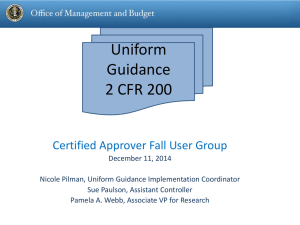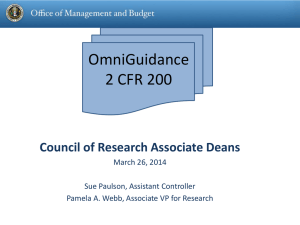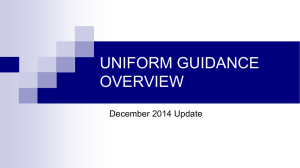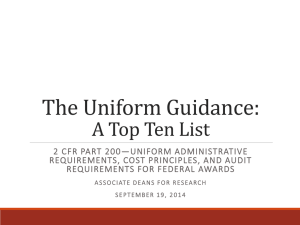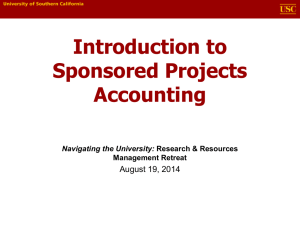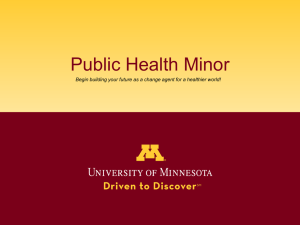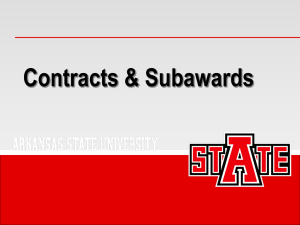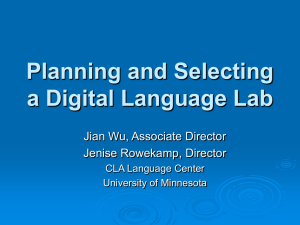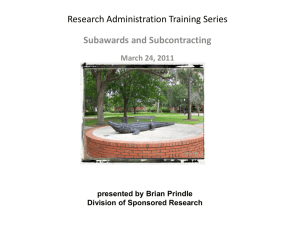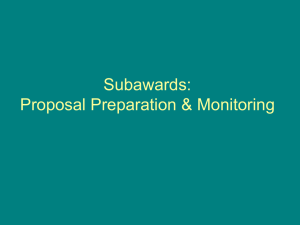Uniform Guidance – Pamela Webb, Nicole Pilman, Sue Paulson
advertisement
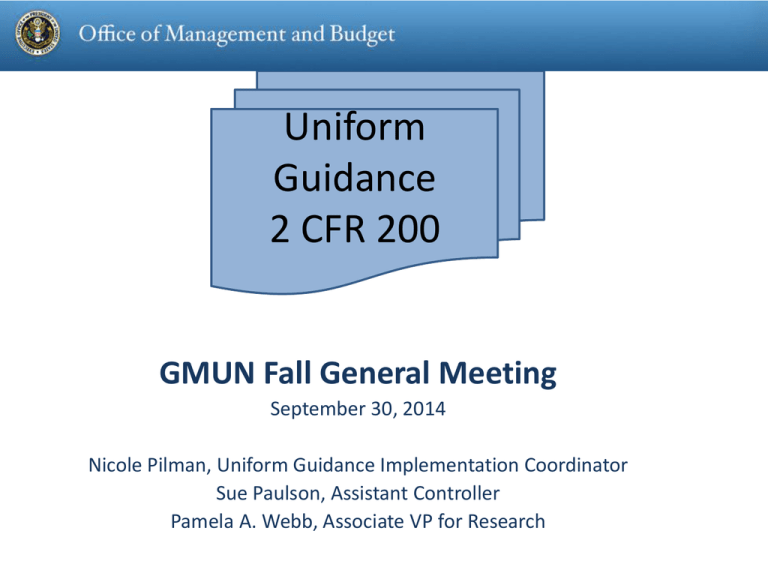
Uniform Guidance 2 CFR 200 GMUN Fall General Meeting September 30, 2014 Nicole Pilman, Uniform Guidance Implementation Coordinator Sue Paulson, Assistant Controller Pamela A. Webb, Associate VP for Research Goals of Updated Regulations METRICS METRICS Reduce fraud, waste, and abuse METRICS METRICS METRICS METRICS METRICS vs. METRICS METRICS METRICS OmniGuidance Implementation Plan 2013 2014 12/26/13 Release 6/26/14 Agency plans due to OMB Understand 2015 T o d a y 12/26/14 Implementation (all but audit) 2016 7/1/15 Audit provisions go into effect for UMN (OmniGuidance) Influence Plan (OmniGuidance) Understand (Agency) Plan (Agency) Implement Evaluate Refine Uniform Guidance Org Chart Nicole Pilman, Uniform Guidance Implementation Coordinator (1 yr) Pamela Webb (Co-Chair) Suzanne Paulson (Co-Chair) Uniform Guidance Steering Committee COSTING Kevin McKoskey Seth Goldberg PROPERTY Jay Delaney Individual Specialists PRE-AWARD/ SUBAWARD Andrea Marshall Judy Krzyzek COI Work Lynn Zentner HR/EFFORT David Hagen Gayle Anderson PURCHASING Beth Tapp POST-AWARD Marjorie Nebo Jill Neu Recent Developments • • • • • • • NSF releases draft implementation plan for comment (5/9/14) COGR (including UMN) proposes FAQs to OMB (6/24/14) UMN responds to NSF’s draft (7/2/14) OMB raises potential new definition of MTDC (8/27/14) OMB puts out 30 pages of FAQs (8/29/14) UMN releases PI Quick Guide (9/4/14) COGR (including UMN) puts out updated implementation tracking guidance (9/17/14) OMB FAQs Resolved Certain Issues • Procurement rules to be delayed 1 year – Largest impact for UMN is a new requirement to get 3 price quotes on purchases between $3K and $10K • F&A rate proposals with FY14 base years (like UMN) should use new rules to calculate the rate • COI rules determined to be conflicts in procurement only • Program income rule in UG about including royalties in the definition of what has to be tracked is invalid under federal law • Profit definition clarified to exclude legitimate unexpended balances under fixed price awards/subawards • DS-2 statements submitted after 12/26/14 to true-up charging practices to new rules provide a safe harbor to universities during review by feds (UMN won’t be dinged for inconsistent costing treatment by the feds) Known Effective Dates (as of 9/18/14) • Uniform Guidance will apply to: – All New and Renewal awards issued on or after 12/26/14 (even if costed/budgeted and submitted under the old rules) – UMN’s upcoming F&A rate proposal (to be submitted Spring 2015 against a FY14 base year) – Single (A-133) Audit for UMN’s FY16 (July 2015 – June 2016) • Old Rules (A-21, A-110, A-133) will apply to: – All active awards that do not get incremental funding or another award action (until they expire) • Uniform Guidance may apply to: – All non-competing awards (agencies may decide on a case-by-case basis) PI Quick Guide on Proposal Budgeting • Sent on 9/4/14 to: – All federal PIs and co-Pis (57% opened the email) – AEL list (63% opened) – All Certified Approvers – All Grants Management User Network Users – All SPA and SFR staff – Posted on SPA website – Referenced in UM Brief Please help by also distributing the information to your PIs! Charging Administrative/Clerical and Programmatic Salary Costs • Rules governing “major project or activity” exceptions have been dropped and replaced by the following criteria, all of which must be met: – Administrative or clerical services are integral to a project or activity; – Individuals involved can be specifically identified with the project or activity; – Such costs are explicitly included in the budget or have the prior written approval of the Federal awarding agency; and – The costs are not also recovered as indirect costs. • If all requirements are met, add a new justification statement to proposals to facilitate the required agency approval. Charging Administrative/Clerical and Programmatic Salary Costs cont. • UMN has determined that integral means: – the services are essential, vital, or fundamental to the project or activity; AND – a minimum of 15% FTE is budgeted in the grant’s budget year or there are documented special circumstances • Justification Statement example: – “This award includes management of 15 subawards. This volume and the tight timeline of the project mandate more extensive monitoring than the services routinely provided by the department. A XX% time program assistant is needed to oversee the subrecipients’ activities, including working with SPA to perform risk assessment and subrecipient monitoring, ensuring timely delivery and review of invoices, acquiring progress reports and ensuring their review, resolving midproject issues, monitoring compliance approvals, ensuring timely payments, and handling subaward modifications We are therefore requesting agency approval for a [List % time appointment here] [List position title here] as an administrative cost allowed under 2 CFR 200.413.” Charging Administrative/Clerical and Programmatic Salary Costs cont. • Examples of Projects that might meet definition of “intergral”: – Large, complex programs, such as General Clinical Research Centers, program projects, research centers, and other grants and contracts that entail assembling and managing teams of investigators from a number of institutions. – Projects which involve extensive data accumulation, analysis and entry, surveying, tabulation, cataloging, searching literature, and reporting (such as epidemiological studies, clinical trials, and retrospective studies of clinical records). – Projects that require making travel and meeting arrangements for large numbers of participants, such as conferences and seminars. – Projects where the principal focus is the preparation and production of manuals and large reports, books, or monographs (excluding routine progress and technical reports). – Projects that are geographically inaccessible to normal departmental administrative services, such as research vessels, and other field research remote from campus. – Projects requiring significant amounts of project-specific database management; individualized graphics or manuscript preparation; human or animal protocols, and multiple project-related investigator coordination and communications. Charging Administrative/Clerical and Programmatic Salary Costs cont. • After the award has been issued, seek agency approval through a letter prepared by the PI and countersigned by SPA if: – New or additional support is needed that is greater than 25% of approved effort at time of award (reductions are not subject to approval) • PIs should allow 30 days for this process – Therefore, no new or additional support can start until after agency approval is received. • If approved, SPA will revise the budget if a PeopleSoft friendly budget accompanies the letter request. – Otherwise, it is assumed that the Certified Approver will make the budgetary revision. Charging Administrative/Clerical and Programmatic Salary Costs cont. • Programmatic Costs… – may be direct charged using the same underlying requirements as other types of direct costs – are NOT subject to the extra approval requirements required of administrative and clerical costs • Examples of Programmatic Costs: – – – – protocol development and maintenance managing substances/chemicals managing and securing project-specific data coordination of research subjects Computing Devices (Under $5,000 Unit Cost) • Computing devices under $5,000/unit may be direct charged under the following circumstances: – The machines are essential* and allocable to the project – They are necessary to acquire, store, analyze, process, and publish data and other information electronically, • including accessories (or “peripherals”) for printing, transmitting and receiving, or storing electronic information – The project does not have reasonable access to other devices or equipment that can achieve the same purpose • devices may not be purchased for reasons of convenience or preference. • Items costing more than $5,000 per unit are considered equipment and follow federal equipment rules * PIs are responsible for determining whether or not the device is “essential” and to what extent the cost of the device is allocable to the sponsored project. PIs and departments should maintain documentation that describes how the proposed computing device meets the above requirements. Participant Support Costs • Participant support costs are not routinely allowed on research projects but can be charged with agency approval and the project includes: – An education or outreach component and the agency approves such costs. • Participant support costs may include: – Stipends or subsistence allowances – Travel allowances – Registration fees paid to or on behalf of participants or trainees (but not employees) in connection with conferences or training projects • These costs should be explicitly listed in the proposal budget or approved by the funding agency after the award has been made. Visa Costs • Since short-term visas are issued for a specific period of time and purpose, they can be direct charged to a Federal award if: – They can be clearly identified as directly connected to work performed on a Federal award – They are critical and necessary to the project and are allowable by the agency. • These visas allow employees and students to engage in field research or attend meetings in foreign locations, or allow foreign visitors to visit the University in support of the project. • Long-term visa costs, such as those that enable employment at the University (for example “J” and “H1B” visas) are not allowable as direct charges. F&A on Subawards • UMN and all of its subrecipients must use a federal program’s rate if it has a published statutory F&A cap. • For all other federal programs, the subrecipient’s federally negotiated F&A rate must be used if there is one. • If there is no negotiated F&A rate, a 10% de minimus F&A rate must be used, or the PI/department may request that SPA negotiate an F&A rate with the subrecipient. • Entities that have previously received negotiated rates with UMN are grandfathered in and UMN will continue to negotiate rates with these entities until they qualify to negotiate a rate directly with the federal government. • PIs may not negotiate or agree to lower rates with their subrecipients. • There is no change to UMN’s recovery of its own F&A – this remains limited to receiving our F&A on the first $25K of each subaward. F&A on Subawards cont. • SPA will, in rare circumstances, will negotiate a rate with a proposed subrecipient when the subrecipient: – Does not qualify to receive a rate directly from the federal government (currently, this means the entity does not receive direct federal funding of $750K or more per year) – Is expected to do at least $750,000 of business annually with UMN – There is reason to believe the F&A rate will be substantially higher than 10% MTDC. • If SPA agrees to negotiate a rate, 60 days advance notice (before the proposal is due to SPA) is required. Fixed Price/Rate Subawards • Agency prior approval is required to enter into a fixed price/rate subaward and the total value of each fixed price/rate subaward may not exceed $150K. • This will impact approximately 20% of all subawards issued by UMN, which are most commonly used for clinical trial site agreements, foreign subrecipients, and small businesses. • General research collaborations are not likely to be issued as fixed price. • To expedite agency approval, PIs/departments should add a new justification statement to proposals contemplating a fixed price/rate subaward. (A statement is not needed for other subawards.) Fixed Price/Rate Subawards cont. • Justification Statement: – “The subaward to [Name the subrecipient here] documented in this proposal meets the criteria described in Subpart C- 200.201(b) and the University of Minnesota is therefore requesting prior agency approval of this Fixed Price Subaward. The University will consider this subaward approved if an award is made and no contrary guidance from the agency is included in the award notice.” Fixed Price/Rate Subawards cont. • Consult your SPA GA if: – If you are uncertain about how to set up the subaward at time of proposal – If you need multiple fixed price subawards to the same subrecipient to stay under the $150K threshold per subaward. • Other things to note: – You will be able to do an after-award-issuance request if it is determined that a fixed price subaward is needed, but not included in the proposal. – SPA reserves the right to make the final determination at time of subaward issuance whether to issue the subaward on a fixed price basis or cost-reimbursement basis. • This is true regardless of whether a fixed price justification statement was included in the proposal. Possible Topics of Next PI Quick Guide • Process for tracking and documenting review of subrecipient progress reports • Review and approve subrecipient invoices as quickly as possible to meet the new 30 day requirement • Agency prior approval of fixed price subawards added after the award starts (unless the agencies waive this prior approval) • Determine how to follow new Procurement rules (eventually) • Publication costs can be directed charged between award end date and date of final financial report • 90 day (or 120 day for NIH and maybe more agencies?) enforced closeout Expected Next Developments • Work with COGR/OMB to solve MTDC definition issue • UMN UG Steering and Work Groups continue to meet to discuss emerging developments and local impact of new regs – Known policy/procedure changes will begin going through the review process soon • Federal agency implementation plans not likely to be released until Nov or December 2014 (for 12/26/14 implementation) • Federal “Research Terms and Conditions” replacement may or may not be ready for 12/26/14 – Would include an updated Prior Approvals matrix • UMN to create a PI Quick Guide on Award Management for release in late fall Questions??? • Additional information available at: – http://www.ospa.umn.edu/documents/UG.html
